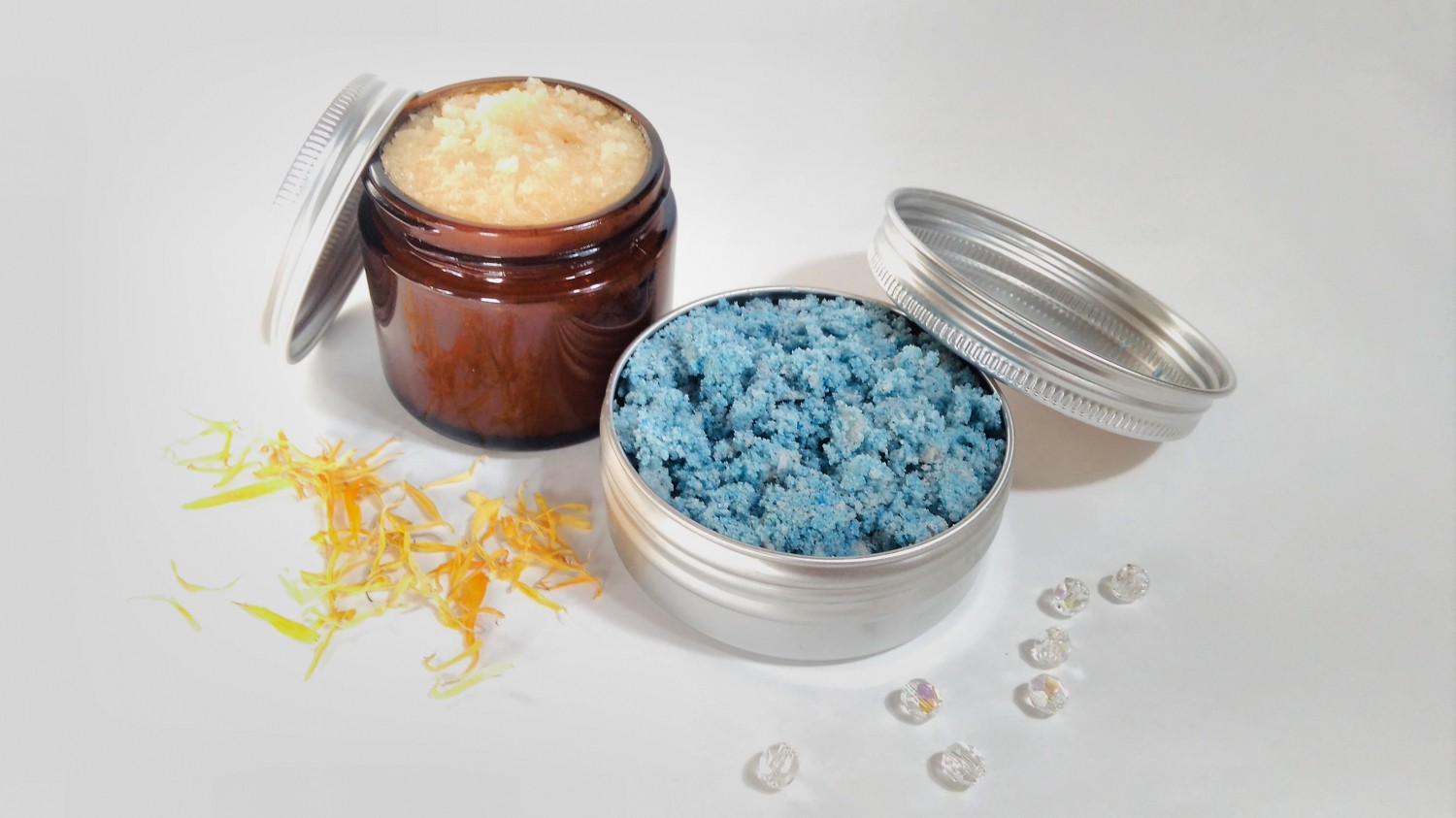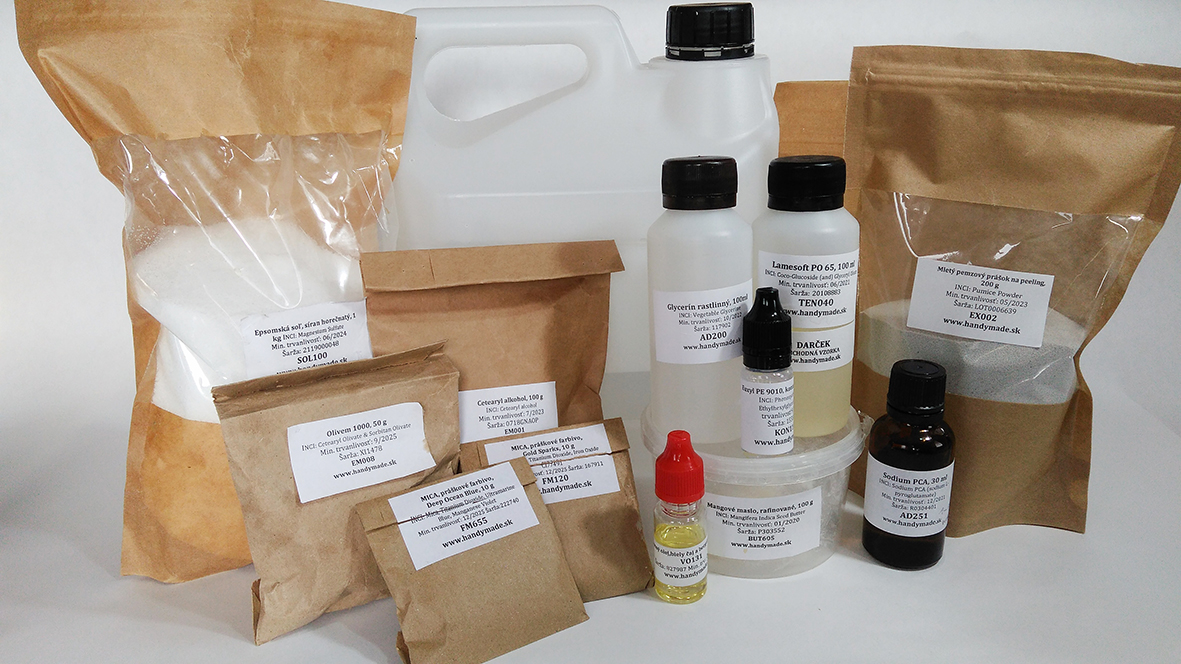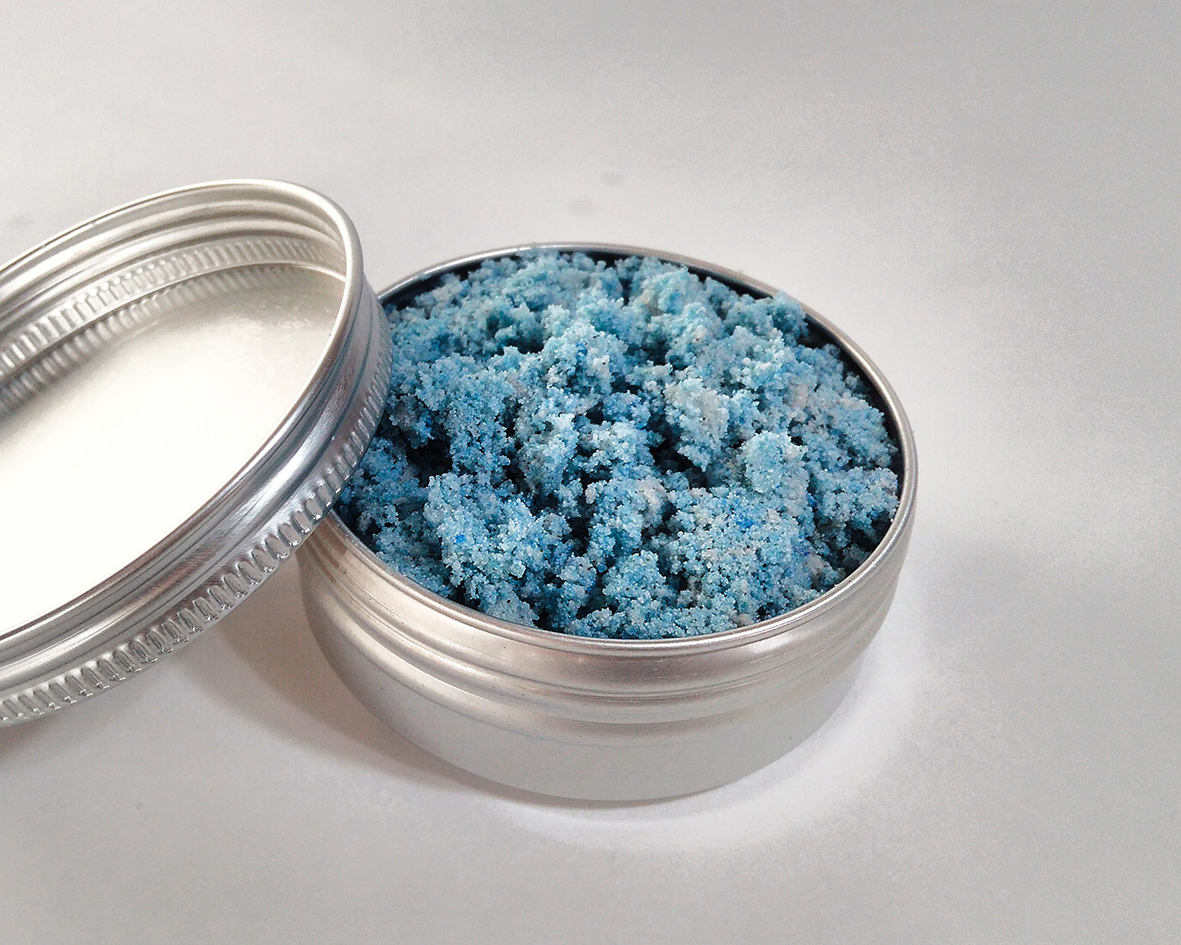Foaming shower scrub
With the foaming shower scrub you combine fun with useful. Create it with us
Did you know that you can also make a shower scrub at home? We bring you two simple recipes for making basic foaming shower scrubs, which you can, of course, vary to suit yourself.
Let your imagination run wild and experiment with scents, colours or different exfoliants and oils.

FOAMING SHOWER SCRUB - INGREDIENTS
Below you will find two recipes for making shower scrubs, which differ in the type usedthe type of exfoliant used in each shower scrub is different, but also the proportion of each ingredient, so that each scrub produces a different feeling on the skin. You can choose a soft and fluffy scrub with pumice powder or a slightly firmer version for more effective removal of hardened and dead skin using Epsom salts.
Shower scrub with pumice powder
7% Demineralised water
7 % SCI
6 % Lamesoft PO 65
8,5 % Glycerine vegetable
0,5 % Mica powder - Deep Ocean Blue
3 % Cetearyl alcohol
6 % Mango butter
5 % Olivem 1000
50 % Pumice powder
1 % Euxyl 9010 - preservative
5 % Sodium PCA
1 % Fragrance oil - white tea and bergamot
aluminium jar, 50 ml
Shower scrub with Epsom salt
7 % Demineralised water
6 % SCI
6 % Lamesoft PO 65
8,5 % Glycerine vegetable
0,5 % Mica powder - Gold sparks
3 % Olivem 1000
7 % Mango butter
2 % Cetearyl alcohol
57 % Epsom salt
1 % Euxyl 9010 - preservative
1 % Sodium PCA
1 % Fragrance oil - white tea and bergamot
glass jar, 50 ml

FOAMING SHOWER SCRUB - PROCEDURE
Regardless of which of the two recipes you choose, the procedure remains the same for preparing both shower scrubs. On the following lines you will find out how to do it:
1. disinfect all containers and utensils that come into contact with the ingredients or product (e.g. using ethanol).
2. wear a respirator (SCI is a very fine powder that is easily released into the air), ideally also gloves. Mix water, glycerine, SCI, lamesoft and mica powder in one container, cover with foil
and place on the water bath. At this point a respirator will no longer be needed.
3. in a second container (heat resistant) weigh out the mango butter, cetearyl alcohol and emulsifier - olivem 1000. Cover with tin foil and allow to heat on the water bath until dissolved.
4.once dissolved, pour the water phase into the oil phase (i.e. the phase with the mango butter) and start mixing immediately with a hand mixer until whipped to a creamy consistency.
5.finally, add the preservative, fragrance oil, sodium PCA and mix well. Then add the exfoliant (Epsom salt/pumice powder) and mix well again.
6. fill into a container of your choice, such as an aluminium or glass cream jar.
FOAMING SHOWER SCRUB AND ITS VARIATIONS
The foaming shower scrub contains many ingredients that you can vary according to your needs, or you can even leave some out if you don't have them on hand at the moment. By understanding the meaning of the ingredients in a recipe, you can more easily swap them and prepare a recipe exactly to your liking.
EXFOLIENTS
Two different abrasive exfoliants were used in the recipes, namely Epsom salt and pumice powder. Pumice powder is a fine grey powder that is very gentle on the skin. Epsom salt is a slightly rougher version of the scrub, particularly suitable for dry and hard skin, such as on the soles of the feet.
The exfoliants mentioned above can be replaced by any other exfoliant. The choice is really wide, from ground shells of various nuts to sugar, salt or ground coffee and so on. You may find that you have to adjust quite a bit of cetearyl alcohol and emulsifier to make the scrub firm enough for good scooping
from the container and use.
EMULGATOR
The emulsifier used in our recipes was olivem 1000. This is a great emulsifier for beginners, you can use it to make a wide range of products from body lotions and creams to shower scrubs.
If you are out of olivem 1000 for a year, you can substitute with Beautyderm K10 or another emulsifier, for example.however, be aware that each emulsifier is slightly different and this may affect the final consistency of the product.
Cetearyl alcohol has been used in the recipe to add strength to the finished foaming shower scrub mixture. It also has mild emulsifying properties, so it combines well with oils or emulsifiers. An excellent substitute for it is cetyl alcohol with similar properties.
You can also reach for stearic acid, but again, using the same amount of stearic acid as cetearyl alcohol can give you a mixture with a slightly different consistency. Increasing the thickener content will give you a stiffer scrub, while decreasing the content will cause you to get closer to a creamy consistency.
VEGETABLE BUTTERS AND OILS
Mango butter is a great skin conditioning butter. However, it is far from your only choice. You can choose any other vegetable oil or butter. It just depends on your preference. If you increase the proportion of fat in the product, you will get a scrub that will be more buttery and nourishing to the skin. Conversely, by decreasing the oil or butter representation in the recipe, you will get a more foaming and degreasing foaming shower scrub.
TENZIDY
SCI and lamesoft PO 65 are the two tensides responsible for the foaming and degreasing effects of the shower scrub. That is why these two ingredients cannot be omitted, because it will no longer be a foaming shower scrub, you will only get an ordinary shower scrub, which will indeed remove dead skin, but it will not foam.
It is also difficult to substitute the two tensides, as a major change in their ratio or substitution with other substances can cause the emulsion and the whole product to break down. If you have to replace either of the tensides, replace lamesoft with the liquid tenside cocamidopropyl betaine, but you will get a product with slightly different foaming
and degreasing properties.
When selecting tensides, always ensure that they are compatible, i.e. do not combine tensides with opposite charges - anionic with cationic.
DEMINERALISED WATER
Demineralised water is a suitable environment for dissolving tensides. However, this can also be replaced by floral waters, hydrolates, which also gently fragrance your product. choose the hydrolates that best suit your skin, or prepare a mixture of several hydrolates.
GLYCERINE
the role of glycerin in a foaming shower scrub recipe is to add moisture and suppleness to the skin. Also for this reason, it's a good idea to incorporate it into the water phase. However, if you don't currently have it, you can also omit it altogether and replace it with more exfoliant.
MICA BREAD
The beautiful colours of the scrubs were obtained thanks to the use of mica powders. These powders are simply incorporated into the water or oil phase. However, you can omit the mica powders from the recipe altogether, in which case the product will have the colour of the predominant ingredient, i.e. the exfoliant. In the case of pumice powder, the scrub will be grey,
if you use various ground nut shells or jojoba beads, the foaming shower scrub will turn brown.
FRAGRANCE OIL
An option to add an interesting scent to the product is to use fragrance oils. Fragrance oils offer a wide variety of fruity, floral or woody scents that you can combine in different ways. If you prefer essential oils, you can substitute them for the fragrance oil you use. Another option is to avoid perfuming altogether,
if you wish.
SODIUM PCA
Sodium PCA is a great moisturizing agent for the skin, so it helps to nourish the skin during showering and soothe the signs of dry skin. It has similar properties to glycerin, helping to keep skin supple and moisturised. Sodium PCA can be omitted from the recipe altogether, but if you want to add a touch of luxury to your shower scrub, we recommend leaving sodium PCA in the recipe.
CONSERVANT
As there is water in the recipe, it is necessary to use a preservative in the product. Euxyl 9010 has the advantage of working over a wide pH range, so it is not necessary to adjust the pH of the product before adding the preservative.
At the same time, the foaming scrub will be used primarily during showering and bathing, and so there is a risk of excess water getting into the product, for example when scooping with wet hands.
Therefore, a preservative in this kind of cosmetic product is essential.
Euxyl 9010 can be substituted with any other broad spectrum preservative that works over a wide pH range (i.e. not only acidic but also neutral pH).
FOAMING SHOWER SCRUB - PACKAGING AND STORAGE

As mentioned, wide-mouth containers are suitable for packaging the shower scrub to facilitate scooping of the product. Glass, plastic or aluminium cream jars
with a capacity of at least 50 ml for ease of handling fall into this category.
Always close the product tightly after use to prevent further unwanted water from entering the product. This will also keep the product fresh for longer. We also recommend storing out of direct sunlight and in a cooler place if possible.
NOTICE
As mentioned, you can experiment with homemade recipes to achieve the desired properties. However, many factors such as humidity, temperature, quality of ingredients and storage can affect the final result.
Before using any raw material to make a cosmetic product, familiarize yourself with its properties, recommended dosage, storage conditions or safe handling. Any raw material may have the potential to cause an allergic reaction in sensitive individuals, so before using a product, we recommend that you find out if you suffer from an allergy to any of the raw materials or the overall product, e.g. by a skin test.
If you have very sensitive or very acne-prone skin, or other skin and health problems, we recommend that you consult a medical professionalbefore applying a new product to your skin, whether it is a homemade cosmetic product, a pure raw material or a commercially available product.
FOAMING SHOWER SCRUB - CONCLUSION
So what my friends,
did you manage to make your foaming shower scrub? Was it fun?
We really enjoyed making the shower scrub and enjoyed using it even more.
If you have any questions about the making process or the ingredients themselves, feel free to email us at marketing@handymade.sk
Share your insights and ideas with us so we can keep improving the process for you.
Until we see you again, have a great creative day.
Goodbye, my friends.


